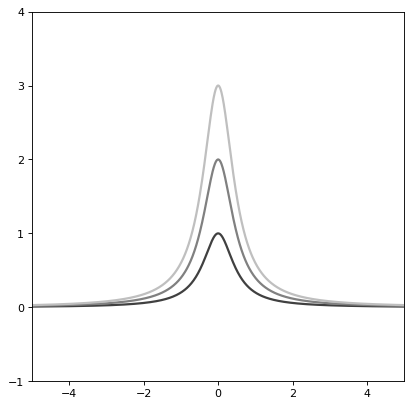Lorentz1D¶
- class astropy.modeling.functional_models.Lorentz1D(amplitude=1, x_0=0, fwhm=1, **kwargs)[source]¶
Bases:
Fittable1DModelOne dimensional Lorentzian model.
- Parameters:
- Other Parameters:
- fixed
apython:dict, optional A dictionary
{parameter_name: boolean}of parameters to not be varied during fitting. True means the parameter is held fixed. Alternatively thefixedproperty of a parameter may be used.- tied
python:dict, optional A dictionary
{parameter_name: callable}of parameters which are linked to some other parameter. The dictionary values are callables providing the linking relationship. Alternatively thetiedproperty of a parameter may be used.- bounds
python:dict, optional A dictionary
{parameter_name: value}of lower and upper bounds of parameters. Keys are parameter names. Values are a list or a tuple of length 2 giving the desired range for the parameter. Alternatively, theminandmaxproperties of a parameter may be used.- eqcons
python:list, optional A list of functions of length
nsuch thateqcons[j](x0,*args) == 0.0in a successfully optimized problem.- ineqcons
python:list, optional A list of functions of length
nsuch thatieqcons[j](x0,*args) >= 0.0is a successfully optimized problem.
- fixed
See also
Notes
Either all or none of input
x, positionx_0andfwhmmust be provided consistently with compatible units or as unitless numbers.Model formula:
\[f(x) = \frac{A \gamma^{2}}{\gamma^{2} + \left(x - x_{0}\right)^{2}}\]where \(\gamma\) is half of given FWHM.
Examples
import numpy as np import matplotlib.pyplot as plt from astropy.modeling.models import Lorentz1D plt.figure() s1 = Lorentz1D() r = np.arange(-5, 5, .01) for factor in range(1, 4): s1.amplitude = factor plt.plot(r, s1(r), color=str(0.25 * factor), lw=2) plt.axis([-5, 5, -1, 4]) plt.show()

Attributes Summary
This property is used to indicate what units or sets of units the evaluate method expects, and returns a dictionary mapping inputs to units (or
Noneif any units are accepted).Names of the parameters that describe models of this type.
Methods Summary
evaluate(x, amplitude, x_0, fwhm)One dimensional Lorentzian model function
fit_deriv(x, amplitude, x_0, fwhm)One dimensional Lorentzian model derivative with respect to parameters
Attributes Documentation
- amplitude = Parameter('amplitude', value=1.0)¶
- fwhm = Parameter('fwhm', value=1.0)¶
- input_units¶
- param_names = ('amplitude', 'x_0', 'fwhm')¶
Names of the parameters that describe models of this type.
The parameters in this tuple are in the same order they should be passed in when initializing a model of a specific type. Some types of models, such as polynomial models, have a different number of parameters depending on some other property of the model, such as the degree.
When defining a custom model class the value of this attribute is automatically set by the
Parameterattributes defined in the class body.
- x_0 = Parameter('x_0', value=0.0)¶
Methods Documentation